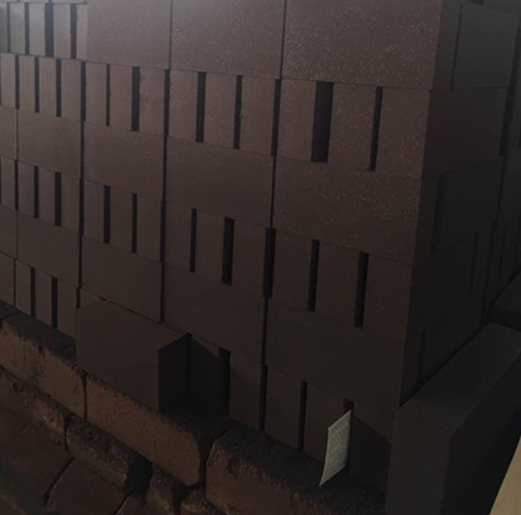- 08
- Sep
Low chromium magnesia chrome bricks for cement kilns and direct bonded magnesia chrome bricks
Low chromium magnesia chrome bricks for cement kilns and direct bonded magnesia chrome bricks
Magnesia chrome bricks are refractory products with magnesium oxide (MgO) and chromium trioxide (Cr2O3) as the main components, and periclase and spinel as the main mineral components. This kind of brick has high refractoriness, high temperature strength, strong resistance to alkaline slag erosion, excellent thermal stability, and certain adaptability to acid slag. The main raw materials for making magnesia-chrome bricks are sintered magnesia and chromite. The purity of magnesia raw materials should be as high as possible. The requirements for the chemical composition of chromite are: Cr2O3 : 30 ~ 45% , CaO : ≤1.0 ~ 1.5% .
Magnesium chrome bricks are mainly used in the metallurgical industry, such as the construction of open hearth furnace tops, electric furnace tops, out-of-furnace refining furnaces and various non-ferrous metal smelting furnaces. The high-temperature part of the furnace wall of the ultra-high power electric furnace is made of fused-cast magnesia-chrome bricks, the high-erosion area of the refining furnace outside the furnace is made of synthetic materials, and the high-erosion area of the non-ferrous metal flash smelting furnace is made of fused-cast magnesia-chrome bricks and synthetic materials. Made of magnesia chrome bricks. In addition, magnesia-chrome bricks are also used in the burning zone of cement rotary kilns and regenerators of glass kilns.

The physical and chemical properties of low chromium magnesia chrome bricks and direct bonded magnesia chrome bricks used in cement kilns are as follows :
| പദ്ധതി | Low chromium magnesia chrome brick | Directly combined with magnesia chrome brick |
| ബൾക്ക് സാന്ദ്രത | 2.85-2.95 | 3.05-3.20 |
| Hot flexural strength | ഏകദേശം 1 | 6-16 |
| Creep rate | -0.03 | + 0.006-0.01 |
| Reburn line changes | -0.2 | + 0.2-0.8 |
| Load softening temperature | 1350 | 1500 |
Related to the composition and performance of these two types of bricks, different industries and points should be paid attention to in the practice of using in cement kilns.
1. Brick lining
Directly combined with magnesia-chrome bricks below 1500, the line change can reach +0.2%-0.8% . There are steel plates or refractory mud in the brick circle to absorb this expanded single joint material, so the clean masonry method without steel plates or fire mud cannot be used. , And low chromium magnesia chrome bricks are provided with a cardboard cushion, the latter with a cardboard thickness of 2mm
2. Baking kiln
Directly bonded magnesia-chrome bricks are more sensitive to the internal stress of the brick lining caused by heating and the ellipticity of the kiln body, so strict control is required.
Directly bonded magnesia-chrome bricks contain a lot of chromium, have low resistance to alkali corrosion in the oxidizing atmosphere, and the bonding bonds of the chromium-containing phase are destroyed. The bricks are easy to damage and cause serious pollution to the environment.
3. Resistance to reducing atmosphere
The same reaction occurs in both types of bricks in a reducing atmosphere, which destroys the bonding phase and eventually leads to damage to the bricks. The direct bonding of magnesia-chrome bricks will be more severely affected.
4. Influence on the formation of kiln skin
A layer rich in C4AF will be formed between the low-chromium and high-iron magnesia-chrome brick lining and the clinker , so the kiln skin performance is better. The performance of the kiln skin directly combined with the magnesia-chrome brick varies with the composition of the brick. Once the kiln skin is normal When the formation and maintenance are good, the temperature of the brick surface under the kiln skin drops greatly, and it is not very important to directly combine the advantages of the high thermal strength of the magnesia chrome brick.
Has now come out several low chrome magnesia-chrome brick, chrome-free special brick, the production capacity of up to 6000-10000T / h of PC kiln, the high temperature and thermal shock resistance are extremely important, they developed a corresponding tip Spar combined with high purity chromium-free special magnesium is mainly used in the transition zone of cement kilns.
